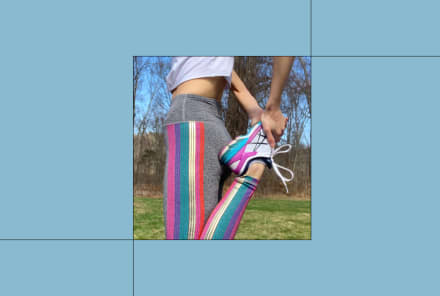Advertisement
A 6-Step Life Detox To Get Rid Of A Bad Relationship

Does a toxic relationship have you feeling down in the dumps? If so, you're not alone. As a therapist who helps women manage career and relationship concerns, I frequently see clients who feel stuck in an unfulfilling relationship with a partner, friend or family member.
Although toxic relationships are certainly draining and dissatisfying, oftentimes there’s something about the dynamic that’s difficult to leave behind. So you keep putting energy into maintaining the relationship despite the fact that it’s taking a toll on your life.
Whether you're left feeling anxious or insecure, angry or upset, the bottom line is this: if you’re dissatisfied with the relationship and your needs aren’t being met, it’s time to make some changes.
I should note that "letting go" of a toxic relationship doesn’t necessarily mean ending it; it means releasing yourself from the grip the toxic dynamic of the relationship has on you. And that gesture of release can start with certain choices you make.
If you're having trouble letting go of a toxic relationship or simply don't know where to start, try this six-step detox to lighten up your life.
Step 1: Understand the role you’re playing in the dynamic.
It’s true: certain people have a knack for causing drama, and being in a relationship with them can feel like an uphill battle. You want to give them the benefit of the doubt, but it always seems to blow up in your face.
If this sounds familiar, take a moment to consider how and what you're contributing to the relationship, and why it's generating toxicity. Do you have a pattern of seeking relationships with the wrong partners? Do you work too hard to maintain relationships with people who don't appreciate you?
Oftentimes an underlying issue such as low self-esteem or fear of abandonment can unknowingly cause us to cling to relationships that aren’t working. Simply becoming aware of what's motivating you is the first step in breaking the cycle. If you need help, a therapist can offer an unbiased perspective.
Step 2: Set healthy boundaries.
Now that you have some clarity as to why you're holding on to this relationship, it's time to start putting your own needs first. The concept of self-care is simple in and of itself, but putting yourself first takes its own kind of discipline. So give yourself some space to focus on your own well-being.
Remind yourself that you don't need to respond to every toxic text message, or drop everything to spend time with someone who only wants to see you when it's convenient for them. Accept that there might be some backlash when you set new boundaries — so be it. It’s time to start making yourself a priority, so take a deep breath and move on to Step 3.
Step 3: Practice mindfulness. (The key word here is practice.)
Odds are, you’ll feel anxious or upset when you distance yourself from this relationship, and that’s OK. Although being aware of why we hold on to toxic relationships is the first step in breaking the cycle, change doesn’t happen overnight.
We may always have certain vulnerabilities and triggers, but we don’t always have to give in to them. So, work on being mindfully present. When your mind comes back to anxious thoughts about the relationship, notice those thoughts and let them go. Focusing on your breath is a great way to quiet the mind chatter and bring your attention back to the present moment.
With practice, you'll find that mindfulness seeps its way into other areas of your life, and allows you to have greater self-awareness and acceptance, especially during trying times.
Step 4: Reconnect with your tribe.
If you’ve been neglecting other relationships (or avoiding them altogether because you don’t want to hear what your friends and family have to say about your toxic relationship), it’s time to reconnect with them. At this point, you’re probably so accustomed to the emotional roller-coaster of a volatile relationship that you’ve forgotten what it’s like to have fun without the drama.
That's exactly why spending time with the people who love and appreciate you will not only be a welcome relief, but a crucial method of healing. Plus, you'll soon remember what it feels like to be treated with the respect you deserve.
Step 5: Make time for simple gestures of self-love.
Do something just for you, because you’re worth it. Try something new, like a photography class, or make time to regularly visit your yoga studio. Making yourself a priority in a concrete, simple way will boost your self-esteem, and give you the confidence you need to own your individuality and maintain healthy boundaries.
Step 6: Determine what you value.
Make a list of what you value most in life and what makes you feel most fulfilled. Writing your answers down will help you remember them down the road. You’ll also likely see a theme emerge, which can provide some much-needed direction if your relationship has been distracting you from other areas of your life.
Instead of fixating on your toxic relationship, think about what makes you shine and feel happy — and put your focus there. When you put your energy into living an authentic life, you’ll find that everything else tends to fall into place.
Watch Next
Enjoy some of our favorite clips from classes
Enjoy some of our favorite clips from classes
What Is Meditation?
Mindfulness/Spirituality | Light Watkins
Box Breathing
Mindfulness/Spirituality | Gwen Dittmar
What Breathwork Can Address
Mindfulness/Spirituality | Gwen Dittmar
The 8 Limbs of Yoga - What is Asana?
Yoga | Caley Alyssa
Two Standing Postures to Open Up Tight Hips
Yoga | Caley Alyssa
How Plants Can Optimize Athletic Performance
Nutrition | Rich Roll
What to Eat Before a Workout
Nutrition | Rich Roll
How Ayurveda Helps Us Navigate Modern Life
Nutrition | Sahara Rose
Messages About Love & Relationships
Love & Relationships | Esther Perel
Love Languages
Love & Relationships | Esther Perel
What Is Meditation?
Box Breathing
What Breathwork Can Address
The 8 Limbs of Yoga - What is Asana?
Two Standing Postures to Open Up Tight Hips
How Plants Can Optimize Athletic Performance
What to Eat Before a Workout
How Ayurveda Helps Us Navigate Modern Life
Messages About Love & Relationships
Love Languages
Advertisement

Why Women Are Twice As Likely To Struggle With Depression & Anxiety
Phyllis E. Greenberger, MSW

Why Women Are Twice As Likely To Struggle With Depression & Anxiety
Phyllis E. Greenberger, MSW









